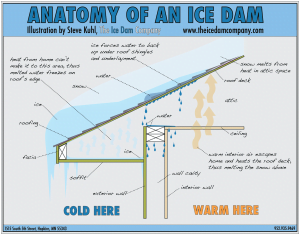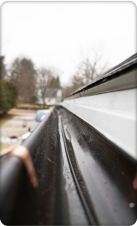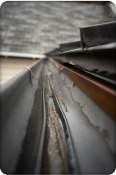Heated Gutter Services in Lancaster, PA
Using Heat Tape To Create A Heated Gutter
A heated gutter system consists of a gutter fitted with self-regulating heat tape, which is threaded through the gutters and downspouts beneath a gutter guard. During winter, the heat tape warms the gutter to prevent issues that can arise from snow and ice accumulation.
Talk to us about Heated Gutters Today!
Why Heated Gutters?
Homeowners living in colder climates often worry about ice dams forming on their roofs, which can lead to leaks and significant water damage.
Harsh winters can make these problems worse, sometimes resulting in costly repairs. Large icicles that form along the roof’s edge above walkways and driveways aren’t just unsightly and can pose a safety hazard. In more severe situations, the combined weight of snow and ice may cause gutters to crack, pull away from the house, or even collapse entirely.
Many people choose to install heat tape on their gutters to help prevent these issues and offer some peace of mind. This specially designed cable gently warms up to melt snow and ice, effectively reducing the risk of ice dams without harming their homes.
What About Heated Tape on the Roof?
Unlike traditional roof heat cables that are laid out in a zigzag pattern along the roof’s edge, our approach involves installing heated gutter cables—sometimes referred to as heat tape—inside the gutters, just beneath a gutter guard system, and within the downspouts. This integrated method of using heated gutters and gutter guards addresses many of the issues commonly associated with standard roof heat tape or cable installations.
The effectiveness of heat tape really depends on how it is installed. Many companies opt for the popular zigzag pattern, which creates a series of triangles across the first few feet of the roof and then continues with the cable running inside the gutter and downspout. While this setup can melt snow and ice on the roof’s surface, it does not prevent ice dams from forming within the gutters. As a result, ice can still accumulate and block water flow, leading to clogs and potential damage.
Moreover, installing heat tape directly on the roof has been shown to cause more long-term harm to the roofing material than not using any cable at all, and it could even void your roof’s warranty.
Heat Tape works better inside a Gutter System
We use Weather-Ready heat tape, which is installed exclusively inside the gutters and downspouts. By keeping the heat tape within these areas, the shingles remain untouched, the tape stays protected, and only the gutters are heated. This approach is not only highly effective but also maintains an attractive appearance. When paired with a gutter guard, the system traps the heat inside, ensuring the entire gutter stays warm. As snow on the roof melts, it encounters both a warm gutter guard and a warm gutter, which prevents ice and snow from accumulating in your gutter system. This means your gutters only need to handle water, not ice.
For the best results, it’s important to turn on the heat cable just before snowfall begins. Heated cables are especially important in regions with harsh winters and heavy snowfall, as they help prevent ice dams and keep water from seeping into your home.
Snow Guards
Snow Guards, which should not be mistaken for Gutter Guards, serve an important purpose for roofs in areas that experience heavy snowfall. They are specifically designed to prevent accumulated snow or ice from sliding off the roof all at once, which could otherwise result in an avalanche that poses a risk to landscaping or anyone walking below.
Ice Dams
Ice dams typically form when a roof has uneven or insufficient insulation, or when other factors cause temperature fluctuations that allow snow to melt and flow down the roof. As this melted snow reaches the colder area over the eaves, it refreezes, creating a buildup of ice at the roof’s edge or in the gutters. This accumulation traps more ice and water above it, which can then seep under the shingles and make its way into your attic, ceilings, and interior walls. As a result, water damage may occur inside your home, potentially leading to costly repairs and even the need for mold remediation.
What Causes Ice Damming?
There are a variety of reasons behind this problem. The most common reasons for ice damming are:

The pitch of a roof plays a significant role in how quickly ice damming can develop, with lower-pitched roofs being more susceptible. Homeowners often notice ice damming around bathroom vents and chimneys, largely due to fluctuating temperatures in these areas.
Traditional roof heat cables are typically installed on top of the roof, leaving them exposed and sometimes ineffective, as ice can still form above the cables. This simply shifts the problem higher up the roof, away from the protection of the drip edge and the ice and water shield. When the heat tape does manage to melt snow, the resulting water can refreeze as it moves downward toward the gutter, which is generally colder than the roof itself because it is surrounded by cold air. In contrast, a heated gutter system uses gutter heat tape to warm the entire gutter, effectively preventing this refreezing issue.
Without such a system, ice often accumulates in the gutters first, leading many people to wonder whether gutters themselves are the cause of ice dams.
Why Gutter Guards are an important part of a Heated Gutter System?
Gutter guards serve more than just the purpose of preventing leaves and debris from clogging your gutters; they also reinforce the gutter structure, offer protection for heat cables, and help keep snow out so it can melt more quickly. When heat tape is installed inside the gutter, it allows the entire system to warm up, efficiently melting snow as it lands and reducing the risk of ice buildup that could cause water damage inside your home or create large, hazardous icicles along your roofline. In contrast, if the heat cable is left exposed to the elements, it can become damaged, and leaves and debris are more likely to get caught on it, compromising the effectiveness of your gutter system.
Are Heated Gutters Safe? What about potential fire hazards?
The Nuheat Weather-Ready heat tape installed by The Brothers that just do Gutters features a UV-resistant polyolefin outer jacket, a tinned copper braided layer, and a fire-resistant conductive core. Nuheat industries mandate that each heating cable circuit includes equipment ground-fault protection to further reduce the risk of fire from continuous electrical arcing, which can occur if the cable is damaged or improperly installed. In certain situations, a licensed electrician may be required to complete the final connection. Placing heat cable directly on the roof’s surface presents a potential fire hazard, making proper installation and adherence to safety guidelines essential
How much electricity does it use?
Your actual electrical usage will depend on the length of the cable run, as well as the way the Nuheat Weather-Ready heat tape responds to its environment. This heat tape is designed to self-regulate its power output based on changes in ambient conditions. When the temperature drops and there is ice or snowfall, the tape increases its power output. As the temperature of the water and ice rises, the tape uses less wattage and emits less heat. For more information, you can refer to our Cost of Heated Gutter Systems.
Heated Gutter Demonstration
We put together a video demonstration of how a heated gutter system works. We placed piles of snow on top of the gutters so that viewers can see them melt through a time-lapse video.
To achieve the best results, it’s important to turn on your heat cable before a snowstorm begins. This allows the heated gutter to melt snowflakes as soon as they land, preventing buildup. If there is already a layer of ice or snow on the gutter, the heat cable will still melt it, but the process will take longer and use more energy.
In this simulation, we began with a mound of snow already present on the gutter, but in a real snowstorm, the falling flakes would melt immediately upon contact with the heated surface. For more information and tips, be sure to explore our many blogs on this subject.
Installing Heat Tape – Using Heat Tape To Create A Heated Gutter
When installing heat tape, it’s important to consider several factors to ensure effective performance. Spacing is a key element, which varies based on the pitch of your roof and the length of the soffit. The heated cable is typically placed inside your gutters and downspouts, and the most effective approach is to install it beneath a gutter guard. Using a gutter guard is highly recommended because it shields the cable and helps retain heat, improving the overall efficiency of the system and reducing the risk of problems like ice dams.
To supply power to the heat tape, you can use a premade length of heat tape or a GFCI plug-in cord set, which can be connected directly to an existing outdoor outlet and removes the need for hardwiring. However, if you do not have an outdoor outlet available or if your setup makes these solutions unworkable, it may be necessary to consult an electrician to complete the power connection safely.
Table of Contents
Why Heated Gutters?
What about Heat Tape on the Roof?
Heat Tape works better inside a Gutter System
Snow Guards
Ice Dams
What Causes Ice Damming?
Why Gutter Guards are an important part of a Heated Gutter System?
Are Heated Gutters Safe? What about potential fire hazards?
How much electricity does it use?
Heated Gutter Demonstration
Installing Heat Tape
Talk to us about Heated Gutters Today!
Design the Perfect Gutter System
Complete the form today to book your free gutter estimate! Our solutionist will guide you through your options and craft a custom system for your house.



